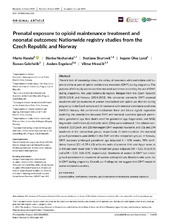| dc.contributor.author | Handal, Marte | en_US |
| dc.contributor.author | Nechanská, Blanka | en_US |
| dc.contributor.author | Skurtveit, Svetlana | en_US |
| dc.contributor.author | Lund, Ingunn Olea | en_US |
| dc.contributor.author | Gabrhelík, Roman | en_US |
| dc.contributor.author | Engeland, Anders | en_US |
| dc.contributor.author | Mravčík, Viktor | en_US |
| dc.date.accessioned | 2020-05-14T15:59:00Z | |
| dc.date.available | 2020-05-14T15:59:00Z | |
| dc.date.issued | 2019-08-14 | |
| dc.Published | Handal M, Nechanská B, Skurtveit S, Lund IO, Gabrhelík R, Engeland A, Mravčík V. Prenatal exposure to opioid maintenance treatment and neonatal outcomes: Nationwide registry studies from the Czech Republic and Norway. Pharmacology Research & Perspectives. 2019;7:e00501(5) | eng |
| dc.identifier.issn | 2052-1707 | |
| dc.identifier.uri | https://hdl.handle.net/1956/22282 | |
| dc.description.abstract | There is lack of knowledge about the safety of treatment with methadone and buprenorphine as part of opioid maintenance treatment (OMT) during pregnancy. The purpose of this study was to examine neonatal outcomes concerning the use of OMT during pregnancy. We used nationwide registry linkages from the Czech Republic (2000‐2014) and Norway (2004‐2013). We compared prenatally OMT–exposed newborns with (a) newborns of women hospitalized with opioid use disorder during pregnancy in the Czech sample and (b) newborns with neonatal abstinence syndrome (NAS) in Norway. We performed multivariate linear and binary logistic regression exploring the associations between OMT and neonatal outcomes (growth parameters, gestational age, fetal death, small for gestational age, Apgar score, and NAS). Regression coefficients (b) and odds ratios (ORs) were estimated. The cohorts consisted of 333 Czech, and 235 Norwegian OMT–exposed newborns, and 106 and 294 newborns in the comparison groups, respectively. In both countries, the neonatal growth parameters were similar in the OMT and the comparison groups. In Norway, OMT exposure prolonged gestational age (adjusted b = 0.96 weeks, 95% confidence interval [CI] =0.39‐1.53) while the odds of preterm birth and Apgar score at 5 minutes were lower than in the comparison group (adjusted OR = 0.35, 0.16‐0.75 and aOR = 0.21, 0.06‐0.78, respectively). Newborns of women in OMT had similar growth parameters as newborns of women with opioid use disorders who were not in OMT during pregnancy. Overall, our findings do not suggest that OMT results in worse neonatal outcomes. | en_US |
| dc.language.iso | eng | eng |
| dc.publisher | Wiley | eng |
| dc.rights | Attribution CC BY | eng |
| dc.rights.uri | http://creativecommons.org/licenses/by/4.0/ | eng |
| dc.title | Prenatal exposure to opioid maintenance treatment and neonatal outcomes: Nationwide registry studies from the Czech Republic and Norway | en_US |
| dc.type | Peer reviewed | |
| dc.type | Journal article | |
| dc.date.updated | 2019-11-13T08:36:03Z | |
| dc.description.version | publishedVersion | en_US |
| dc.rights.holder | Copyright 2019 The Author(s) | |
| dc.identifier.doi | https://doi.org/10.1002/prp2.501 | |
| dc.identifier.cristin | 1746149 | |
| dc.source.journal | Pharmacology Research & Perspectives | |

